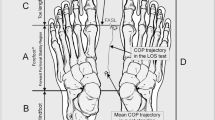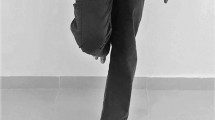Abstract
Ankle complex proprioception and plantar sole sensitivity have been separately reported to be essential sensory components in balance control among the elderly. However, their inter-relationship is still unknown. Further, although optimal proprioceptive ability has been related to regular physical exercise, the association between physical activity (PA) levels, ankle proprioceptive acuity and plantar cutaneous sensation is unclear. Therefore, this study aims to compare ankle proprioceptive acuity and plantar cutaneous sensitivity scores between groups of older women with different PA levels, and to determine any relationships between plantar sole cutaneous sensitivity, ankle proprioceptive performance and PA levels. 68 older female participants were recruited who were distributed over three PA levels: highly active, moderately active, and inactive. PA level was assessed by the International Physical Activity Questionnaire. Ankle proprioceptive acuity was tested in full weight-bearing stance using the ankle Active Movement Extent Discrimination Apparatus (AMEDA) and plantar cutaneous sensitivity was assessed with the Nylon Semmes–Weinstein monofilaments test. Results showed that ankle proprioceptive acuity scores were strongly positively related to plantar sole sensitivity scores (r = 0.80, p < 0.001; effect size: η2 = 0.715), and both scores correlated with PA level. In conclusion, plantar cutaneous sensitivity and ankle complex proprioception were strongly correlated in older females with different levels of physical activity, suggesting that the former may be an integral part of the latter. Given the previously reported contribution of AMEDA ankle proprioceptive acuity to sport performance level, the health of the plantar sole of the foot may be important as a performance determinant.


Similar content being viewed by others
References
Aimonetti J-M, Hospod V, Roll J-P, Ribot-Ciscar E (2007) Cutaneous afferents provide a neuronal population vector that encodes the orientation of human ankle movements. J Physiol 580(2):649–658. https://doi.org/10.1113/jphysiol.2006.123075
Benjuya N, Melzer I, Kaplanski J (2004) Aging-induced shifts from a reliance on sensory input to muscle cocontraction during balanced standing. J Gerontol Ser A Biol Sci Med Sci 59(2):166–171
Billot M, Handrigan GA, Simoneau M, Corbeil P, Teasdale N (2013) Short term alteration of balance control after a reduction of plantar mechanoreceptor sensation through cooling. Neurosci Lett 535(1):40–44
Billot M, Handrigan GA, Simoneau M, Teasdale N (2015) Reduced plantar sole sensitivity induces balance control modifications to compensate ankle tendon vibration and vision deprivation. J Electromyogr Kinesiol 25(1):155–160
Booth J, Young MJ (2000) Differences in the performance of commercially available 10-g monofilaments. Diabetes Care 23(7):984–988
Cathers I, Day BL, Fitzpatrick RC (2005) Otolith and canal reflexes in human standing. J Physiol 563(1):229–234. https://doi.org/10.1113/jphysiol.2004.079525
Chen X, Qu X (2019) Age-related differences in the relationships between lower-limb joint proprioception and postural balance. Hum Factors 61(5):702–711. https://doi.org/10.1177/0018720818795064
Edin BB (2001) Cutaneous afferents provide information about knee joint movements in humans. J Physiol 531(1):289–297. https://doi.org/10.1111/j.1469-7793.2001.0289j.x
Edin BB, Abbs JH (1991) Finger movement responses of cutaneous mechanoreceptors in the dorsal skin of the human hand. J Neurophysiol 65(3):657–670. https://doi.org/10.1152/jn.1991.65.3.657
Edin BB, Johansson N (1995) Skin strain patterns provide kinaesthetic information to the human central nervous system. J Physiol 487(1):243–251
Gilsing M, Van den Bosch C, Lee S, Ashton-Miler J, Alexander N, Schultz A, Ericson W (1995) Association of age with the threshold for detecting ankle inversion and eversion in upright stance. Age Ageing 24(1):58–66
Gurfinkel VS, Ivanenko YP, Levik YS (1994) The contribution of the foot deformation to the changes of muscular length and angle in ankle joint during standing in human. Physiol Res 43:371–371
Han J, Anson J, Waddington G, Adams R (2013) Proprioceptive performance of bilateral upper and lower limb joints: side-general and site-specific effects. Exp Brain Res 226(3):313–323
Han J, Waddington G, Anson J, Adams R (2015b) Level of competitive success achieved by elite athletes and multi-joint proprioceptive ability. J Sci Med Sport 18(1):77–81
Han J, Waddington G, Adams R, Anson J, Liu Y (2016) Assessing proprioception: a critical review of methods. J Sport Health Sci 5(1):80–90
Han J, Anson J, Waddington G, Adams R, Liu Y (2015a) The role of ankle proprioception for balance control in relation to sports performance and injury. BioMed Res Int 2015:842804
Hatton A, Dixon J, Rome K, Brauer S, Williams K, Kerr G (2016) The effects of prolonged wear of textured shoe insoles on gait, foot sensation and proprioception in people with multiple sclerosis: study protocol for a randomised controlled trial. Trials 17:208
Horak FB, Shupert CL, Hlavačka F (1995) Vestibular-somatosensory interactions for human posture. In: Hlavačka F, Mergner T (eds) Multisensory control of posture. Springer, Boston
Hurley MV, Rees J, Newham DJ (1998) Quadriceps function, proprioceptive acuity and functional performance in healthy young, middle-aged and elderly subjects. Age Ageing 27(1):55–62
Ivanenko Y, Gurfinkel VS (2018) Human postural control. Front Neurosci 12:171
Katzman R, Zhang MY, Ouang YQ, Wang ZY, Liu WT, Yu E et al (1988) A Chinese version of the mini-mental state examination; impact of illiteracy in a Shanghai dementia survey. J Clin Epidemiol 41(10):971–978
Kavounoudias A, Roll R, Roll J-P (1998) The plantar sole is a ‘dynamometric map’ for human balance control. NeuroReport 9(14):3247–3252
Kavounoudias A, Roll R, Roll JP (2001) Foot sole and ankle muscle inputs contribute jointly to human erect posture regulation. J Physiol 532(Pt 3):869–878
Kennedy PM, Inglis JT (2002) Distribution and behaviour of glabrous cutaneous receptors in the human foot sole. J Physiol 538(Pt 3):995–1002
Korchi K, Noé F, Bru N, Paillard T (2019) Optimization of the effects of physical activity on plantar sensation and postural control with barefoot exercises in institutionalized older adults: a pilot study. J Aging Phys Act 27(4):1–14
Kumar S, Fernando D, Veves A, Knowles EA, Young M, Boulton A (1991) Semmes-Weinstein monofilaments: a simple, effective and inexpensive screening device for identifying diabetic patients at risk of foot ulceration. Diabetes Res Clin Pract 13(1–2):63–67
Lirani-Silva E, Vitório R, Barbieri F, Orcioli-Silva D, Simieli L, Gobbi L (2017) Continuous use of textured insole improve plantar sensation and stride length of people with Parkinson’s disease: a pilot study. Gait Posture 58:495–497
Macfarlane DJ, Lee CCY, Ho EYK, Chan KL, Chan DTS (2007) Reliability and validity of the Chinese version of IPAQ (short, last 7 days). J Sci Med Sport 10(1):45–51
Machado ÁS, Bombach GD, Duysens J, Carpes FP (2016) Differences in foot sensitivity and plantar pressure between young adults and elderly. Arch Gerontol Geriatr 63:67–71
Macmillan N, Creelman C (2005) Detection theory: a user’s guide. Lawrence Erlbaum Associates, New York, p 73
Madhavan S, Shields RK (2005) Influence of age on dynamic position sense: evidence using a sequential movement task. Exp Brain Res 164(1):18–28. https://doi.org/10.1007/s00221-004-2208-3
Maitre J, Jully JL, Gasnier Y, Paillard T (2013) Chronic physical activity preserves efficiency of proprioception in postural control in older women. J Rehabil Res Dev 50(6):811–820
Mayfield J, Sugarman J (2000) The use of the Semmes-Weinstein monofilament and other threshold tests for preventing foot ulceration and amputation in persons with diabetes. J Fam Pract 49(11 Suppl):S17-29
McNicol D (2005) A primer of signal detection theory. Psychology Press, Hove
Menadue C, Raymond J, Kilbreath S, Refshauge K, Adams R (2006) Reliability of two goniometric methods of measuring active inversion and eversion range of motion at the ankle. BMC Musculoskelet Disord 7:60–60
Menz HB, Lord SR, Rebecca SG, Fitzpatrick RC (2004) Walking stability and sensorimotor function in older people with diabetic peripheral neuropathy. Arch Phys Med Rehabil 85(2):245–252
Menz HB, Morris ME, Lord SR (2006) Foot and ankle risk factors for falls in older people: a prospective study. J Gerontol Med Sci 61A(8):866–870
Paulus WM, Straube A, Brandt T (1984) Visual stabilization of posture. Brain 107(4):1143–1163
Perry SD (2006) Evaluation of age-related plantar-surface insensitivity and onset age of advanced insensitivity in older adults using vibratory and touch sensation tests. Neurosci Lett 392(1):62–67
Ribeiro F, Oliveira J (2011) Factors influencing proprioception: what do they reveal? InTech Open, London. https://doi.org/10.5772/20335
Ribeiro F, Oliveira J (2007) Aging effects on joint proprioception: the role of physical activity in proprioception preservation. Eur Rev Aging Phys Act 4(2):71–76. https://doi.org/10.1007/s11556-007-0026-x
Roll R, Kavounoudias A, Roll JP (2002) Cutaneous afferents from human plantar sole contribute to body posture awareness. NeuroReport 13(15):1957–1961
Sherrington C (1906) The integrative action of the nervous system. Yale University Press, New Haven
Singh N, Armstrong D, Lipsky BA (2005) Preventing foot ulcers in patients with diabetes. JAMA 293(2):217–228
Skinner HB, Barrack RL, Cook SD (1984) Age-related decline in proprioception. Clin Orthop Relat Res 184:208–211
Steinberg N, Waddington G, Adams R, Karin J, Tirosh O (2016) The effect of textured ballet shoe insoles on ankle proprioception in dancers. Phys Ther Sport 17:38–44
Sturnieks DL, Tiedemann A, Chapman K, Munro BJ, Murray SM, Lord SR (2004) Physiological risk factors for falls in older people with lower limb arthritis. J Rheumatol 31(11):2272–2279
Van Deursen RWM, Simoneau GG (1999) Foot and ankle sensory neuropathy, proprioception, and postural stability. J Orthop Sports Phys Ther 29(12):718
Viseux FJF (2020) The sensory role of the sole of the foot: Review and update on clinical perspectives. Neurophysiol Clin 50(1):55–68. https://doi.org/10.1016/j.neucli.2019.12.003
Waddington G, Adams R (1999) Discrimination of active plantarflexion and inversion movements after ankle injury. Aust J Physiother 45(1):7–13
Waddington G, Adams R (2000) Textured insole effects on ankle movement discrimination while wearing athletic shoes. Phys Ther Sport 1(4):119–128
Wang TY, Lin SI (2008) Sensitivity of plantar cutaneous sensation and postural stability. Clin Biomech 23(4):493–499
Westlake KP, Wu Y, Culham EG (2007) Sensory-specific balance training in older adults: effect on position, movement, and velocity sense at the ankle. Phys Ther 87(5):560–568
Wright WG, Ivanenko YP, Gurfinkel VS (2012) Foot anatomy specialization for postural sensation and control. J Neurophysiol 107(5):1513–1521
Yang N, Waddington G, Adams R, Han J (2018) Translation, cultural adaption, and test-retest reliability of Chinese versions of the Edinburgh Handedness Inventory and Waterloo Footedness Questionnaire. Laterality 23(3):255–273. https://doi.org/10.1080/1357650x.2017.1357728
Yang N, Waddington G, Adams R, Han J (2019) Age-related changes in proprioception of the ankle complex across the lifespan. J Sport Health Sci 8(6):548–554. https://doi.org/10.1016/j.jshs.2019.06.003
Yang N, Waddington G, Adams R, Han J (2017) Age-related changes in ankle proprioception. In: Paper presented at the medicine and science in sports and exercise
Yümin ET, Şimşek TT, Sertel M, Ankaralı H (2016) The effect of age and body mass index on plantar cutaneous sensation in healthy women. J Phys Ther Sci 28(9):2587–2595. https://doi.org/10.1589/jpts.28.2587
Zhang S, Brad M, Li L (2015) H-Index is important for postural control for people with impaired foot sole sensation. PLoS ONE 10(3):e0121847. https://doi.org/10.1371/journal.pone.0121847
Funding
This work was supported by National Nature Science Foundation of China (No. 31870936), National Education Department of China (Humanities and Social Science) (No. 18YJA890006), Program of Shanghai Academic Research Leader (No. 20XD1423200), and Program of Shanghai Sport Technology (21C005).
Author information
Authors and Affiliations
Corresponding author
Ethics declarations
Conflict of interest
The authors have no conflicts of interest to declare. The datasets generated during and/or analyzed in the current study are available from the corresponding author on reasonable request.
Additional information
Communicated by Francesco Lacquaniti.
Publisher's Note
Springer Nature remains neutral with regard to jurisdictional claims in published maps and institutional affiliations.
Rights and permissions
About this article
Cite this article
Yang, N., Adams, R., Waddington, G. et al. Ankle complex proprioception and plantar cutaneous sensation in older women with different physical activity levels. Exp Brain Res 240, 981–989 (2022). https://doi.org/10.1007/s00221-021-06273-8
Received:
Accepted:
Published:
Issue Date:
DOI: https://doi.org/10.1007/s00221-021-06273-8




